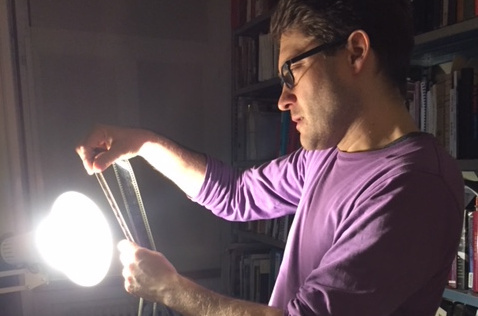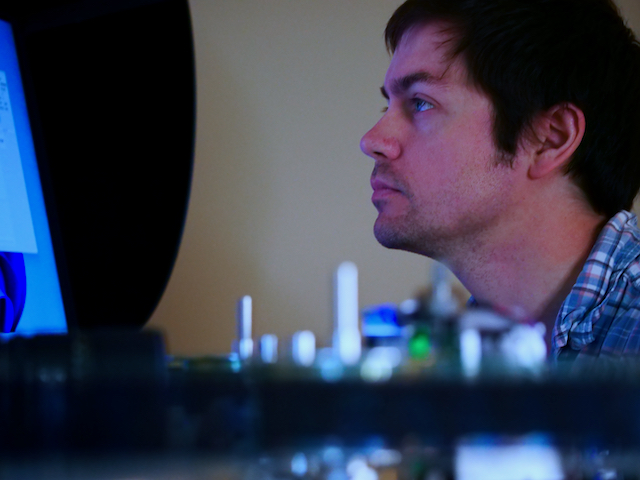
embracing authentic film colors, powered by science
a radically different approach to the digitization of
historical color films and photographs
About Scan2Screen
Scan2Screen is a modular multispectral digitization workflow for historical color films.
It consists of a multispectral scanner and corresponding software for image processing, all of which are based on more than a decade of scientific research into film digitization and historical film colors by Barbara Flueckiger, founder of the Timeline of Historical Film Colors, and the Scan2Screen team..
Currently Scan2Screen has headquarters in Zurich, Switzerland (Scan2Screen Switzerland GmbH), and in Palo Alto, California, USA (Scan2Screen US LLC).
Scan2Screen is a registered trademark.
for authentic film colors
The Affairs of Anatol (USA 1921, Cecil B. DeMille). Courtesy Library of Congress. Tinted nitrate print.
Scan2Screen’s Services
Digitization
- Digitization and / or restoration of historical color films
- Application of a consistently automated and standardized approach that takes into account the core requirements of restoration ethics – transparency, documentation and reversibility – and can react with maximum flexibility to heterogeneous demands from different archiving strategies
- Multispectral, versatile film scanner, fully modular to adjust to future technological innovations and standards
- Fully automated workflows including color management and color reconstruction
- Semantic indexing of films for integration into metadata management and asset management according to international standards
Curation and consulting
- Curation of film restoration projects
- Physical measurements, colorimetry, and documentation of film stocks
- Identification of historical color film stocks
- Consulting for scanner manufacturers and clients
Licensing
- Licensing of hardware and software
Annabelle Butterfly Dance (USA 1897, William K. L. Dickson; William Heise; Annabelle Moore). Courtesy Library of Congress. Hand-colored nitrate print with 4-5% shrinkage.
Scan2Screen Team

Dr. Barbara Flueckiger
CEO Scan2Screen US LLC and founding member Scan2Screen Switzerland GmbH
Professor and award winning film scholar with a technical career in film production. Founder and curator of the Timeline of Historical Film Colors.
E-Mail: flueckiger@scan2screen.com
ORCID | LinkedIn

Dr. Giorgio Trumpy
Imaging scientist, founding member Scan2Screen Switzerland GmbH
Professor, expert in modeling material appearance for heritage conservation
E-mail: trumpy@scan2screen.com
Website | LinkedIn

Lutz Garmsen
Hardware and systems engineering, founding member Scan2Screen Switzerland GmbH
Filmmaker, media artist, apparatus manufacturer, cameraman and animator
E-mail: garmsen@scan2screen.com
Website | LinkedIn

Dr. David Pfluger
Film restorer, CEO Scan2Screen Switzerland GmbH
Media preservation, digitization and digital conservation specialist
E-mail: pfluger@scan2screen.com
Website

Julius Muschaweck
Physicist, CEO JMO GmbH, founding member Scan2Screen Switzerland GmbH
Optics and illumination specialist
E-mail: muschaweck@scan2screen.com
Website | LinkedIn

Martin Weiss
Film scanning, IT, founding member Scan2Screen Switzerland GmbH
Audiovisual preservation specialist, researcher, cameraman
E-mail: weiss@scan2screen.com
Website | LinkedIn

Dr. Natalie Snoyman
Archivist, film historian, team member Scan2Screen US LLC
Specialist in research, project management, curation, and metadata and digitization standards
Email: snoyman@scan2screen.com
LinkedIn

David LeHoty
Applied color science engineer, team member Scan2Screen US LLC
Experienced in D-cinema and phone displays, color calibration, color space conversion, and color appearance and difference
E-Mail: lehoty@scan2screen.com
LinkedIn

Bryan Burns
Film scan operator
Specialist in digital film preservation, restoration, and color correction
E-Mail: burns@scan2screen.com
LinkedIn
All the team members are highly respected experts in the field
with decades of experience building on large international networks
Scan2Screen Workflow

Scan2Screen’s comprehensive multispectral digitization workflow is based on scientific principles.
Its components are fully modular to adjust to future technological innovations and standards.
The visual rendering software calculates the colors automatically according to spectral characteristics of historical cinema projectors,
thus no time-consuming color grading is necessary and subjective interventions are reduced to the max.
Scan2Screen’s Concept
Multispectral Scanning
Scan2Screen presents a completely new paradigm for film digitization that offers significant advantages for those seeking to digitize their most precious color films. Its multispectral design is the industry’s first science-backed workflow that recreates the appearance of a film’s screening in the cinema according to historical analog projection technologies.
More Color Information
Historical film colors differ significantly from modern chromogenic negatives or prints. The dyes and pigments embedded in their film stocks have unique spectral characteristics that often fall outside the gamut of contemporary workflows and devices. Scan2Screen captures the full spectrum of color information, ensuring authentic color rendition that adapts to evolving technologies and standards.

Blue and purple hues as well as green and turquoise tones often fall between spectral bands in other professional film scanners or are even located outside of current gamuts. This problem not only affects scanning of early applied colors but also later chromolytic ones like Gasparcolor or chromogenic
More Flexibility
By capturing the full spectrum of colors, Scan2Screen provides customers with greater flexibility in color processing. Its unique visual rendering software enables the rendition of colors under a range of historical and contemporary cinema projection lights. Additionally, it offers enhanced capabilities for reconstructing faded dyes in chromogenic prints and performs sophisticated negative-to-positive inversion that emulates the opto-chemical process.


More Transparency
Restoration ethics demand three core requirements: transparency, reversibility, and documentation. Unlike most scanners, which operate as black boxes, Scan2Screen’s workflow provides comprehensive documentation of all optical and digital configurations. All six monochrome captures can be stored long-term, allowing full reversibility without the need for rescanning in the future. The scientific principles embedded in the scanner and in the corresponding workflow minimize subjective interventions, aligning with best practices in restoration.

No Color Grading
As color information is captured over the entire visible spectrum, Scan2Screen’s proprietary visual rendering software automatically calculates colors based on the spectral characteristics of specific cinema projections. This eliminates the need for costly and time-consuming color grading, streamlining the process significantly and increasing efficiency, all while improving the end result.

A Material-Based, Scaled Approach
While current trends in film digitization prioritize creating flawless renditions for mass audiences – less grain, more sharpness, less scratches, rock-steady stabilization – preserving historical authenticity remains crucial. There are certainly valid reasons to produce polished products for a broad audience. However as important it is to acknowledge this market-driven demand it should not compromise the pursuit of historical authenticity. Preserving a film’s historical appearance on screen enables film historians and cinephiles to experience its historical aura, complete with the traces of the film’s past.
Therefore Scan2Screen proposes a scaled approach, where the multispectral scanning and post-processing preserve the unique material characteristics of each film element. Customers can then adjust their preferred presentation of the film, opting for a more polished version while still respecting the film’s historical integrity. This approach offers them a range of renditions including various options for individual preferences.
Reach out to Scan2Screen to learn how this approach could fit into your digitization strategy.
Diffuse / directed illumination
While all the wide-spread commercial film scanners use diffuse light only Scan2Screen’s multi-spectral scanner offers diffuse and directed illumination, which can be essential for scanning color films.
The so-called chromatic Callier effect changes color as well as local contrast rendition. Scan2Screen aims at scanning colors true to projection in the cinema, which requires directed illumination. Capturing with both types of optical paths enables you to combine the best from both worlds, the crisp images and colors from directed illumination with the reduced scratches and dirt from diffuse illumination, see our paper Trumpy / Flueckiger (2019) in the publications section..
Video: Multi-spectral scan of Gaumont Fragments, mordant toning, rendered with the spectral characteristics of a historical projector, courtesy of Lichtspiel | Kinemathek, Bern. (Down-scaled for web display)
Awards
2019 JTS Technical Award from the CCAAA “for extraordinary contributions to the
technology of the audiovisual archiving field” ,
2022 James A. Lindner Archival Technology medal “In recognition of her outstanding research focused on the digitization and restoration of archival color films” from the
Society of Motion Pictures and Television Engineers in Hollywood.
2023 Turner Medal from the Colour Group (GB) in London ‘in recognition of her outstanding contribution to the field of colour in film”.
Research
Scan2Screen’s innovation was funded by grants from the European Research Council with the prestigious
ERC Advanced Grant (2015–2021) and a Proof of Concept grant (2019–2021) based on research in the previous
projects AFRESA (2008-2010), Film History Re-mastered (2011–2013) and DIASTOR (2013–2015).
Subsequently the Swiss National Science Foundation awarded the team a Bridge Discovery grant for Scan2Screen (2021–2023) with the goal to bring the scientific results to a commercially viable solution.
Publications
A selection of our publications related to Scan2Screen’s innovation:
Trumpy, Giorgio; Hardeberg, Jon Y.; George, Sony; Flueckiger, Barbara (2021): Multispectral Capture of Film Colors with LEDs. In: Colour and Colorimetry Multidisciplinary Contributions. Associazione Italiana Colore. pp. 195–198, (= https://www.zora.uzh.ch/id/eprint/217066/).
Flueckiger, Barbara; Daugaard, Noemi; Stutz, Olivia Kristina (2021): Shattered Provenance in the Digitization of Early Color Films. In: Joanne Bernardi, Paolo Cherchi Usai, Tami Williams and Joshua Yumibe (eds.): Provenance and Early Cinema. Bloomington, Indiana: Indiana University Press. pp. 80–90, (= https://www.zora.uzh.ch/id/eprint/203288/).
Trumpy, Giorgio; Chatterjee, Sreya; Ruedel, Ulrich; Flueckiger, Barbara (2021): A Material Investigation of Color Film Technology Through the Koshofer Collection. In: Proceedings of the International Colour Association (AIC) Conference 2021. International Colour Association. pp. 1329–1334, (= https://www.zora.uzh.ch/id/eprint/217065/).
Trumpy, Giorgio; Hardeberg, Jon Y.; George, Sony; Flueckiger, Barbara (2021): A Multispectral Design for a New Generation of Film Scanners. In: Proc. SPIE 11784, Optics for Arts, Architecture, and Archaeology VIII, 117840Z (8 July 2021). SPIE Optical Metrology, Munich (DE) – online, (= https://www.zora.uzh.ch/id/eprint/205361/).
Trumpy, Giorgio; Flueckiger, Barbara (2019): Chromatic Callier Effect and its Repercussions on the Digitization of Early Film Colors. In: Journal of Imaging Science and Technology, 63,1, Jan. pp. 10506-1–11, (= https://www.zora.uzh.ch/id/eprint/168857/).
Trumpy, Giorgio; Flueckiger, Barbara (2018): Dye Purification. An Image-processing Technique for the Digital Restoration of Chromogenic Film. In: 2018 Colour and Visual Computing Symposium (CVCS). pp. 1–5, (= https://www.zora.uzh.ch/id/eprint/158941/).
Flueckiger, Barbara; Pfluger, David; Trumpy, Giorgio; Croci, Simone; Aydın, Tunç; Smolic, Aljoscha (2018): Investigation of Film Material–Scanner Interaction. Zurich (CH): University of Zurich, University of Basel, Swiss Federal Institute of Technology, Disney Research Zurich, (= https://www.zora.uzh.ch/id/eprint/151114/).
Trumpy, Giorgio; Diecke, Josephine; Gschwind, Rudolf; Flueckiger, Barbara (2018): Cyber-Digitization. Pushing the Borders of Film Restoration’s Ethics. In: Electronic Imaging & the Visual Arts : EVA 2018 Berlin, 7-9 November 2018. pp. 190–195, (= https://www.zora.uzh.ch/id/eprint/158944/).
Trumpy, Giorgio; Flueckiger, Barbara (2015): Light Source Criteria for Digitizing Color Films. In: 2015 Colour and Visual Computing Symposium (CVCS). pp. 1–5, (= https://ieeexplore.ieee.org/document/7274894).
Flueckiger, Barbara (2015): Color Analysis for the Digital Restoration of DAS CABINET DES DR. CALIGARI. In: Joshua Yumibe (ed.): The Moving Image, 15,1. pp. 22–43, (= https://www.zora.uzh.ch/id/eprint/117489/).
Flueckiger, Barbara (2012): Material Properties of Historical Film in the Digital Age. In: NECSUS. European Journal of Media Studies, 1,2. pp. 135–153, (= https://necsus-ejms.org/material-properties-of-historical-film-in-the-digital-age/).
